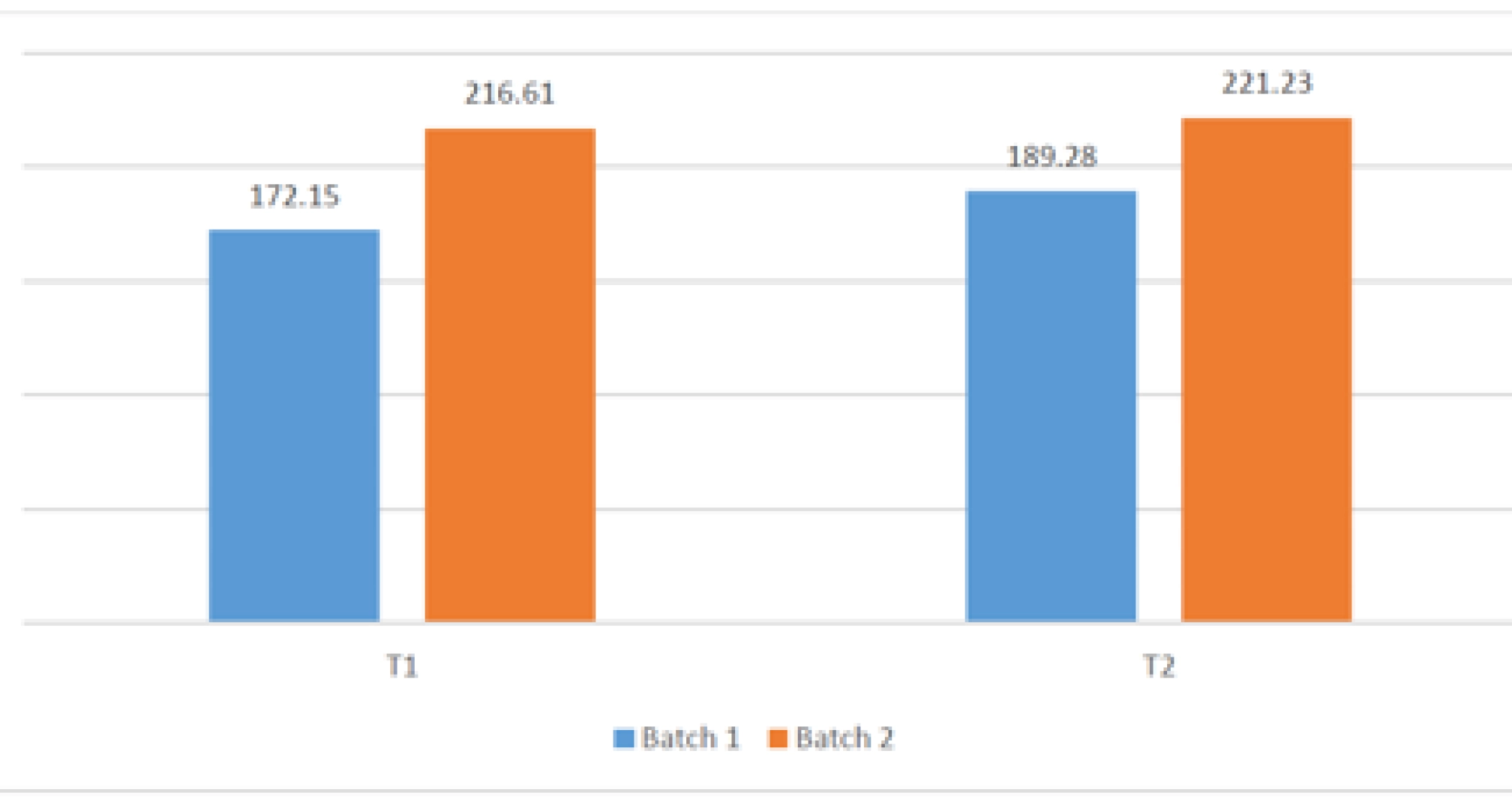
Effect of Ferticote Carbon Coated Fertilizer (CCF) Fertilization on the Growth of Acacia crassicarpa.
Acacia crassicarpa fertilized using CCF Ferticote as basic fertilizer, had a higher plant height and larger stem diameter than plants using ordinary granular NPK fertilizer with specifications 15.15.15.
Fertilization activity is necessary for optimum plant bio-mass production. The purpose of this experiment was to examine the effect of CCF Ferticote fertilizer application on the growth of forestry plants, especially from the species Acacia crassicarpa. The experiment took place in the concession area of an industrial forest plantation (IFP) in Siak Regency.
Carbon Coated Fertilizer (CCF) Ferticote is an NPK fertilizer that is assembled with special technology to reach the macro and micronutrient needs of forestry plants. This NPK fertilizer is equipped with ACTIVE CARBON, an adsorbent derived from the pyrolysis process of biomass. Has the ability to absorb protein and contains paramagnetic compounds.Act as a slow release of ammonium and nitrate. A system that captures soil humic acid and is a breeding ground for bacteria. In addition, this fertilizer also contains HUMIC ACID, a natural soil enhancer that acts as a natural chelating agent and microbial stimulant. Humic acid increases the ability of plants to absorb essential nutrients and improve soil structure.
Combination of activated carbon and humic acid plays a role in increasing soil carbon, chelating macro, and micro nutrients to increase availability to plants for a longer period of time, increasing soil CEC, stimulating soil bacterial growth.
METHODOLOGY
The experiment was divided into two batches. Batch 1 started in June 2013, while Batch 2 with the aim of verifying data Batch 1 started in December 2013.
The type of plant that used is Acacia crassicarpa. Fertilizers experiment are given to seedlings that have just been planted in the field (when transplanting). The soil type at the experimental site belongs to the order Histosol (Peat).
The treatment given to the plant is as follows:
Batch 1
T1. Ash 1 Kg + RP 150 gr + NPK 15.15.15 100 gr
T2. Ash 1 Kg + RP 150 gr + CCF Ferticote 50 gr
T3. Ash 1 Kg + RP 150 gr + CCF Ferticote 75 gr
T4. Ash 1 Kg + RP 150 gr + CCF Ferticote 100 gr
Batch 2
T1. Ash 1 Kg + RP 150 gr + NPK 15.15.15 100 gr
T2. Ash 1 Kg + RP 150 gr + CCF Ferticote 50 gr
For the treatment in the Batch 2 experiment, T1 and T2 treatments were chosen with the goals to verify the results of the Batch 1 experiment where at a dose of 50 g/principal, CCF Ferticote was able to give better results than NPK 15.15.15 fertilizer at a dose of 100 g/principal.
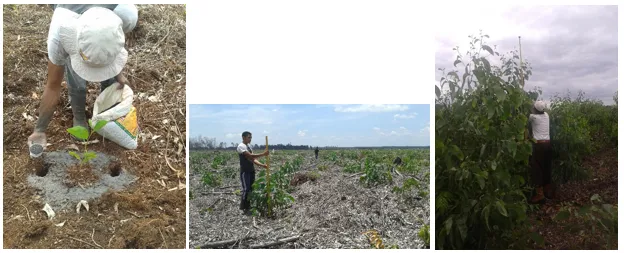
(Left) Acacia crassicarpa at planting and application of CCF Ferticote (Middle) Observation of plant height at 3 months (Right) Plants at 6 months.
Fertilizer is applied by spot placement, fertilizer is sown in the holes on the left and right of the plant. Observations were made by taking 25 sample plants in each plot. Parameters and observation time are:
Plant Height : Age 3, 6, and 12 Months after planting
Stem Diameter : 12 months after planting
RESULTS AND DISCUSSION
Batch 1
At the age of 12 months, all treatments using CCF Ferticote (T2, T3, and T4) gave better results than Acacia crassicarpa has given NPK 15.15.15 fertilizer. The best results were shown by treatment T4 (100 g CCF Ferticote/plant) for plant height parameters and T3 treatment (75 g CCF Ferticote/plant) for stem diameter parameters.
In the plant height parameter, there was the consistency of data where, the greater the dose of CCF Ferticote given, the higher the Acacia crassicarpa produced. Meanwhile, the diameter of the stem at T4 experienced a large decrease in diameter. This requires further study.
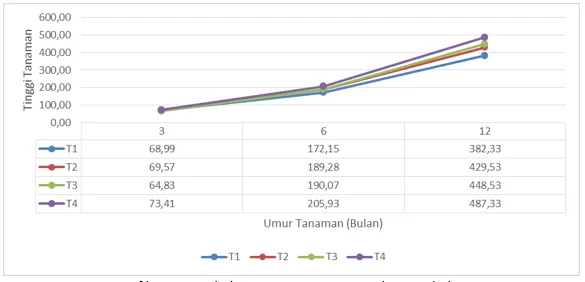
Graph 1. Growth of Acacia crassicarpa for 12 months
The pattern of plant height growth shown in the 4 treatments in this experiment showed a consistent pattern where the T2, T3, and T4 treatments always gave better results than T1 each time. At the age of 3 months, the plant height of T3 was lower than that of T2. This happened because, in one of the T3 replication plots, many plants had stunted growth due to drought stress that occurred in the period June-August 2013. At the age of 6 months (September 2013), the growth pattern of the 4 treatments returned to normal.
Batch 2
As a verification of the results of the experiment which began in June 2013, Batch 2 has been carried out which began in December 2013. The data in graph 2 shows that the plants tested in Batch 2 gave better results than Batch 1. For comparisons between treatments still showed consistent results where Acacia crassicarpa given CCF Ferticote showed higher plant height than those given NPK 15.15.15.
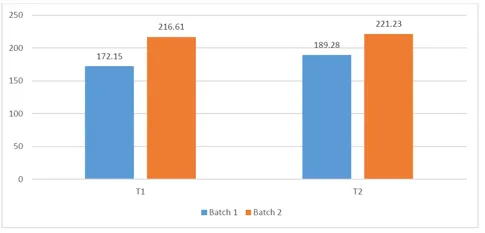
Graph 2. Comparison of plant heights of Acacia crassicarpa aged 6 months between Experiments Batch 1 and 2.
CONCLUSION
The use of CCF Ferticote as a basic NPK fertilizer in the cultivation of Acacia crassicarpa gave better results than the use of NPK 15.15.15 fertilizer at a dose of 100 g/tree. Ferticote CCF fertilizer can be applied at dosage levels of 50, 75, or 100 g/tree depending on the desired results.
***
Fertilization activity is necessary for optimum plant bio-mass production. The purpose of this experiment was to examine the effect of CCF Ferticote fertilizer application on the growth of forestry plants, especially from the species Acacia crassicarpa. The experiment took place in the concession area of an industrial forest plantation (IFP) in Siak Regency.
Carbon Coated Fertilizer (CCF) Ferticote is an NPK fertilizer that is assembled with special technology to reach the macro and micronutrient needs of forestry plants. This NPK fertilizer is equipped with ACTIVE CARBON, an adsorbent derived from the pyrolysis process of biomass. Has the ability to absorb protein and contains paramagnetic compounds.Act as a slow release of ammonium and nitrate. A system that captures soil humic acid and is a breeding ground for bacteria. In addition, this fertilizer also contains HUMIC ACID, a natural soil enhancer that acts as a natural chelating agent and microbial stimulant. Humic acid increases the ability of plants to absorb essential nutrients and improve soil structure.
Combination of activated carbon and humic acid plays a role in increasing soil carbon, chelating macro, and micro nutrients to increase availability to plants for a longer period of time, increasing soil CEC, stimulating soil bacterial growth.
METHODOLOGY
The experiment was divided into two batches. Batch 1 started in June 2013, while Batch 2 with the aim of verifying data Batch 1 started in December 2013.
The type of plant that used is Acacia crassicarpa. Fertilizers experiment are given to seedlings that have just been planted in the field (when transplanting). The soil type at the experimental site belongs to the order Histosol (Peat).
The treatment given to the plant is as follows:
Batch 1
T1. Ash 1 Kg + RP 150 gr + NPK 15.15.15 100 gr
T2. Ash 1 Kg + RP 150 gr + CCF Ferticote 50 gr
T3. Ash 1 Kg + RP 150 gr + CCF Ferticote 75 gr
T4. Ash 1 Kg + RP 150 gr + CCF Ferticote 100 gr
Batch 2
T1. Ash 1 Kg + RP 150 gr + NPK 15.15.15 100 gr
T2. Ash 1 Kg + RP 150 gr + CCF Ferticote 50 gr
For the treatment in the Batch 2 experiment, T1 and T2 treatments were chosen with the goals to verify the results of the Batch 1 experiment where at a dose of 50 g/principal, CCF Ferticote was able to give better results than NPK 15.15.15 fertilizer at a dose of 100 g/principal.

(Left) Acacia crassicarpa at planting and application of CCF Ferticote (Middle) Observation of plant height at 3 months (Right) Plants at 6 months.
Fertilizer is applied by spot placement, fertilizer is sown in the holes on the left and right of the plant. Observations were made by taking 25 sample plants in each plot. Parameters and observation time are:
Plant Height : Age 3, 6, and 12 Months after planting
Stem Diameter : 12 months after planting
RESULTS AND DISCUSSION
Batch 1
At the age of 12 months, all treatments using CCF Ferticote (T2, T3, and T4) gave better results than Acacia crassicarpa has given NPK 15.15.15 fertilizer. The best results were shown by treatment T4 (100 g CCF Ferticote/plant) for plant height parameters and T3 treatment (75 g CCF Ferticote/plant) for stem diameter parameters.
In the plant height parameter, there was the consistency of data where, the greater the dose of CCF Ferticote given, the higher the Acacia crassicarpa produced. Meanwhile, the diameter of the stem at T4 experienced a large decrease in diameter. This requires further study.

Graph 1. Growth of Acacia crassicarpa for 12 months
The pattern of plant height growth shown in the 4 treatments in this experiment showed a consistent pattern where the T2, T3, and T4 treatments always gave better results than T1 each time. At the age of 3 months, the plant height of T3 was lower than that of T2. This happened because, in one of the T3 replication plots, many plants had stunted growth due to drought stress that occurred in the period June-August 2013. At the age of 6 months (September 2013), the growth pattern of the 4 treatments returned to normal.
Batch 2
As a verification of the results of the experiment which began in June 2013, Batch 2 has been carried out which began in December 2013. The data in graph 2 shows that the plants tested in Batch 2 gave better results than Batch 1. For comparisons between treatments still showed consistent results where Acacia crassicarpa given CCF Ferticote showed higher plant height than those given NPK 15.15.15.

Graph 2. Comparison of plant heights of Acacia crassicarpa aged 6 months between Experiments Batch 1 and 2.
CONCLUSION
The use of CCF Ferticote as a basic NPK fertilizer in the cultivation of Acacia crassicarpa gave better results than the use of NPK 15.15.15 fertilizer at a dose of 100 g/tree. Ferticote CCF fertilizer can be applied at dosage levels of 50, 75, or 100 g/tree depending on the desired results.
***
More News
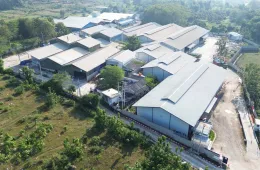 Granular Fertilizer: An Effective Solution for Oil Palm, Horticultural, and Food Crop Plantations
Granular Fertilizer: An Effective Solution for Oil Palm, Horticultural, and Food Crop PlantationsWhat is Granular Fertilizer?
Granular fertilizer is a fertilizer in the form of solid granules with a relatively uniform size. This granule form is produced through mechanical or chemical processing, making it easier to apply to agricultural and plantation land. Compared to powdered or liquid fertilizers, granular fertilizers have several advantages, such as longer shelf life, resistance to clumping, and greater efficiency in nutrient absorption by plants.
Advantages of Granular NPG Fertilizer
1. Easy Application
Granular NPG fertilizer is easy to spread manually or with the help of mechanical equipment, saving time and labor.
2. More Even Nutrient Release
With a uniform granule form, fertilizer distribution across the land is more even. This is crucial to ensuring plants receive a balanced nutritional intake.
3. Minimal Nutrient Loss
Granular fertilizers are more resistant to evaporation and washout during heavy rain, resulting in higher fertilizer efficiency.
4. Suitable for Various Commodities
NPG granular fertilizer is widely used in oil palm plantations, horticulture (chili, tomato, onion), and food crops (rice and corn).
NPG Granular Fertilizer for Oil Palm
Oil palm is a major commodity that requires large and continuous amounts of nutrients. NPG palm fertilizer is the right choice because:
1. Nutrients are more stable in the soil even with high rainfall.
2. Application is more efficient in plantation areas with large hectares.
3. Optimal yields, both for vegetative growth and fresh fruit bunch (FFB) productivity.
As a national granular fertilizer producer, Pupuk NPG has supported many oil palm plantations with NPG palm fertilizer products formulated according to the specific needs of the crop. This has resulted in a sustainable increase in oil palm productivity.
NPG Granular Fertilizer for Horticulture and Food Crops
In addition to oil palm, NPG fertilizer is also increasingly used in the horticulture and food crop sectors.
1. Horticulture: Crops such as chili peppers, tomatoes, and onions require precise fertilization for maximum yields. Granulated NPG fertilizer provides macro and micronutrients with a more controlled release.
2. Food Crops: Rice and corn require fertilizers that can maintain nutrient availability throughout the growing season. NPG fertilizer is a solution for cost efficiency while increasing crop yields.
Granulated NPG Fertilizer and the National Food Security Program
The Indonesian government is currently promoting a national food security program to ensure the availability of strategic food commodities such as rice, corn, soybeans, and various horticultural commodities. Within this program, balanced fertilization and efficient fertilizer use are crucial factors in increasing land productivity.
Granulated fertilizer plays a significant role in supporting this program because it:
1. Ensures more even nutrient distribution.
2. Reduces fertilizer loss due to evaporation or rainwater washout.
3. Increases crop yields in a more sustainable manner.
As a national chemical fertilizer producer, NPG (PT Nusa Palapa Gemilang Tbk.) is committed to supporting the government in achieving food security by providing granular NPG fertilizer tailored to the needs of oil palm plantations, horticulture, and food crops.
Granular Fertilizer Products from NPG
To meet the needs of various agricultural and plantation sectors, NPG (Nusa Palapa Gemilang) offers various variants of NPG granular fertilizer, including a special formulation of NPG palm oil fertilizer:
A. NPK Ferticomp
1. 12-12-17-2
2. 15-15-6-4
3. 13-6-27-4
4. 15-15-15
5. 7-6-34
6. 12-6-22
B. NK Ferticomp
1. 17-28
C. NPK SinutriHS
1. 16-16-16
2. 13-6-27
D. NPK Control Release (CCF Ferticote)
1. 15-25-6
E. NutrimixGT Micro Fertilizer
1. Cu-Zn-B
In addition to the superior products above, NPG can also provide granular fertilizers to order. (customized fertilizer) to support optimal productivity of various agricultural and plantation commodities.
NPG: Partner of Farmers and Plantations
As a national fertilizer producer, NPG (PT Nusa Palapa Gemilang Tbk.) is committed to providing high-quality fertilizers, including NPG palm oil fertilizer and granular fertilizers for various commodities. With its extensive experience, NPG continues to innovate, delivering products tailored to the needs of oil palm, horticultural, and food crop plantations throughout Indonesia...
Granular fertilizer is a fertilizer in the form of solid granules with a relatively uniform size. This granule form is produced through mechanical or chemical processing, making it easier to apply to agricultural and plantation land. Compared to powdered or liquid fertilizers, granular fertilizers have several advantages, such as longer shelf life, resistance to clumping, and greater efficiency in nutrient absorption by plants.
Advantages of Granular NPG Fertilizer
1. Easy Application
Granular NPG fertilizer is easy to spread manually or with the help of mechanical equipment, saving time and labor.
2. More Even Nutrient Release
With a uniform granule form, fertilizer distribution across the land is more even. This is crucial to ensuring plants receive a balanced nutritional intake.
3. Minimal Nutrient Loss
Granular fertilizers are more resistant to evaporation and washout during heavy rain, resulting in higher fertilizer efficiency.
4. Suitable for Various Commodities
NPG granular fertilizer is widely used in oil palm plantations, horticulture (chili, tomato, onion), and food crops (rice and corn).
NPG Granular Fertilizer for Oil Palm
Oil palm is a major commodity that requires large and continuous amounts of nutrients. NPG palm fertilizer is the right choice because:
1. Nutrients are more stable in the soil even with high rainfall.
2. Application is more efficient in plantation areas with large hectares.
3. Optimal yields, both for vegetative growth and fresh fruit bunch (FFB) productivity.
As a national granular fertilizer producer, Pupuk NPG has supported many oil palm plantations with NPG palm fertilizer products formulated according to the specific needs of the crop. This has resulted in a sustainable increase in oil palm productivity.
NPG Granular Fertilizer for Horticulture and Food Crops
In addition to oil palm, NPG fertilizer is also increasingly used in the horticulture and food crop sectors.
1. Horticulture: Crops such as chili peppers, tomatoes, and onions require precise fertilization for maximum yields. Granulated NPG fertilizer provides macro and micronutrients with a more controlled release.
2. Food Crops: Rice and corn require fertilizers that can maintain nutrient availability throughout the growing season. NPG fertilizer is a solution for cost efficiency while increasing crop yields.
Granulated NPG Fertilizer and the National Food Security Program
The Indonesian government is currently promoting a national food security program to ensure the availability of strategic food commodities such as rice, corn, soybeans, and various horticultural commodities. Within this program, balanced fertilization and efficient fertilizer use are crucial factors in increasing land productivity.
Granulated fertilizer plays a significant role in supporting this program because it:
1. Ensures more even nutrient distribution.
2. Reduces fertilizer loss due to evaporation or rainwater washout.
3. Increases crop yields in a more sustainable manner.
As a national chemical fertilizer producer, NPG (PT Nusa Palapa Gemilang Tbk.) is committed to supporting the government in achieving food security by providing granular NPG fertilizer tailored to the needs of oil palm plantations, horticulture, and food crops.
Granular Fertilizer Products from NPG
To meet the needs of various agricultural and plantation sectors, NPG (Nusa Palapa Gemilang) offers various variants of NPG granular fertilizer, including a special formulation of NPG palm oil fertilizer:
A. NPK Ferticomp
1. 12-12-17-2
2. 15-15-6-4
3. 13-6-27-4
4. 15-15-15
5. 7-6-34
6. 12-6-22
B. NK Ferticomp
1. 17-28
C. NPK SinutriHS
1. 16-16-16
2. 13-6-27
D. NPK Control Release (CCF Ferticote)
1. 15-25-6
E. NutrimixGT Micro Fertilizer
1. Cu-Zn-B
In addition to the superior products above, NPG can also provide granular fertilizers to order. (customized fertilizer) to support optimal productivity of various agricultural and plantation commodities.
NPG: Partner of Farmers and Plantations
As a national fertilizer producer, NPG (PT Nusa Palapa Gemilang Tbk.) is committed to providing high-quality fertilizers, including NPG palm oil fertilizer and granular fertilizers for various commodities. With its extensive experience, NPG continues to innovate, delivering products tailored to the needs of oil palm, horticultural, and food crop plantations throughout Indonesia...
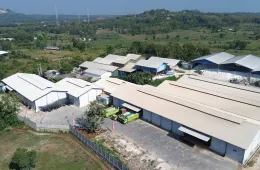 NPGF has recorded an increase in revenue and profit for the first semester of 2025
NPGF has recorded an increase in revenue and profit for the first semester of 2025Gresik, August 20, 2025 – PT Nusa Palapa Gemilang Tbk (NPGF)'s performance showed a positive trend in the first half of 2025. The company posted sales of IDR 71.56 billion, a 37.7% year-on-year (YoY) growth, driven by increased demand for Granulated NPK fertilizer. This achievement also boosted net profit to IDR 1.42 billion, a 33.8% increase compared to the same period the previous year.
NPGF President Director, Ujang Suparman, explained that the surge in demand from the plantation sector was the main driver of performance.
"Demand for our Granulated NPK has increased significantly, particularly from the oil palm plantation and industrial forestry sectors. This is one of the main factors driving the company's sales and profit increases," explained Ujang.
In the first half, the Granulated NPK segment contributed the largest to total revenue, at IDR 55.92 billion. The Briquetted NPK segment contributed IDR 3.83 billion, and the Micro Fertilizer segment recorded IDR 11.29 billion.
New Boost from Early Contracts in Q3
Entering Q3 2025, NPGF secured a new contract worth IDR 71 billion for the procurement of NPK fertilizer for the palm oil, industrial plantations (HTI), food crops, and horticulture sectors in Java, Kalimantan, and Sumatra. This acquisition is considered a significant catalyst for sales performance in the second half. The company stated that it will remain focused on strengthening distribution and increasing capacity in the non-subsidized fertilizer segment, particularly Granulated NPK, to maintain growth momentum until the end of the year.
Outlook for Semester II 2025
Positive financial performance in the first half of 2025 and the successful acquisition of new contracts puts NPGF in a more stable position for the remainder of the year. The company will also implement operational efficiencies and maintain product quality as part of its sustainability strategy. Going forward, the company projects that demand from the plantation sector still has the potential to grow, as agro-industrial activity begins to recover. Consistent sales strategies in the non-subsidized sector are expected to contribute to the realization of NPGF's annual targets for 2025...
NPGF President Director, Ujang Suparman, explained that the surge in demand from the plantation sector was the main driver of performance.
"Demand for our Granulated NPK has increased significantly, particularly from the oil palm plantation and industrial forestry sectors. This is one of the main factors driving the company's sales and profit increases," explained Ujang.
In the first half, the Granulated NPK segment contributed the largest to total revenue, at IDR 55.92 billion. The Briquetted NPK segment contributed IDR 3.83 billion, and the Micro Fertilizer segment recorded IDR 11.29 billion.
New Boost from Early Contracts in Q3
Entering Q3 2025, NPGF secured a new contract worth IDR 71 billion for the procurement of NPK fertilizer for the palm oil, industrial plantations (HTI), food crops, and horticulture sectors in Java, Kalimantan, and Sumatra. This acquisition is considered a significant catalyst for sales performance in the second half. The company stated that it will remain focused on strengthening distribution and increasing capacity in the non-subsidized fertilizer segment, particularly Granulated NPK, to maintain growth momentum until the end of the year.
Outlook for Semester II 2025
Positive financial performance in the first half of 2025 and the successful acquisition of new contracts puts NPGF in a more stable position for the remainder of the year. The company will also implement operational efficiencies and maintain product quality as part of its sustainability strategy. Going forward, the company projects that demand from the plantation sector still has the potential to grow, as agro-industrial activity begins to recover. Consistent sales strategies in the non-subsidized sector are expected to contribute to the realization of NPGF's annual targets for 2025...
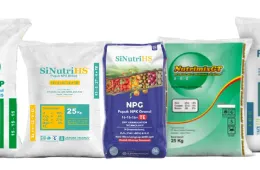 Pupuk NPK: Nutritional Solutions for Productive and Sustainable Oil Palm
Pupuk NPK: Nutritional Solutions for Productive and Sustainable Oil PalmIn modern agriculture, fertilizer plays a vital role. Without adequate nutrient intake, plants cannot grow optimally. Yields will decrease drastically, product quality will decrease, and land efficiency will be compromised. Fertilizers are a solution to meet the nutrient needs of plants during their growth period. Therefore, proper fertilizer use is not only about increasing productivity, but also part of the effort to create a sustainable agricultural system.
Generally, fertilizers can be divided into single fertilizers and compound fertilizers. Single fertilizers contain only one main nutrient, such as nitrogen, phosphorus, or potassium, which serves to correct specific deficiencies in the soil. Meanwhile, compound fertilizers, such as NPK fertilizers, contain a combination of these three main elements in one product, making them a more practical and efficient solution for farmers. NPK fertilizers are available in various formulations to suit plant needs and soil conditions, such as 15-15-15, 13-6-27, and others.
Specifically for oil palm plantations, NPK fertilizer plays a strategic role in boosting long-term productivity. Oil palm plants require the right balance of nutrients to achieve optimal growth. The nitrogen in NPK fertilizer helps accelerate the formation of productive crowns and leaves. Phosphorus supports strong root development and flower formation, while potassium plays a role in increasing fruit formation, oil yield, and plant resistance to environmental stress and disease. With proper fertilization, oil palm plantations not only produce more and heavier fresh fruit bunches (FFB), but also have a longer productive period, thus providing greater economic benefits for farmers.
Beyond simply increasing yields, NPK fertilizer also contributes to national energy security. Palm oil is the primary raw material for biodiesel production, which is now a crucial part of Indonesia's green energy transition, including the B40 program (a 40% biodiesel blend in diesel). Maintaining oil palm productivity will ensure a supply of renewable energy feedstock and help reduce dependence on fossil fuels. In this context, NPK fertilizer not only impacts the agricultural sector but is also a crucial component of the national energy security strategy.
Furthermore, although oil palm is not directly a food crop, its processed products—especially palm oil—are a vital part of the national food chain. Palm oil is widely used as a base ingredient in cooking oil, margarine, and various other food products. The palm oil industry also contributes significantly to the national economy by creating jobs, increasing farmers' incomes, and strengthening people's purchasing power. Even palm oil waste such as empty fruit bunches, boiler ash, and shells can be reused as organic fertilizer and soil amendments, supporting the concept of circular and environmentally friendly agriculture.
As an NPK fertilizer producer committed to national agricultural development, PT Nusa Palapa Gemilang Tbk (NPG) offers fertilizer solutions that are not only high-quality but also tailored to the specific needs of Indonesian tropical agriculture. Through flagship products such as NPG SinutriHS and Ferticomp fertilizers, NPG provides proven formulations that can increase crop yields and cultivation efficiency, especially for strategic crops like oil palm.
SinutriHS and Ferticomp offer complete solutions that combine macro and micro nutrients, suitable for various plant types and soil conditions. Supported by field research and a continuously updated scientific approach, all NPG products are developed to adapt to climate dynamics and current agricultural needs.
More than just a product provider, NPG actively assists farmers and business owners through fertilizer education and technical consultations. This approach makes fertilization more precise, cost-effective, and sustainable. Our commitment is to support national food and energy security through appropriate fertilization—building a fertile, independent, and green Indonesian agriculture...
Generally, fertilizers can be divided into single fertilizers and compound fertilizers. Single fertilizers contain only one main nutrient, such as nitrogen, phosphorus, or potassium, which serves to correct specific deficiencies in the soil. Meanwhile, compound fertilizers, such as NPK fertilizers, contain a combination of these three main elements in one product, making them a more practical and efficient solution for farmers. NPK fertilizers are available in various formulations to suit plant needs and soil conditions, such as 15-15-15, 13-6-27, and others.
Specifically for oil palm plantations, NPK fertilizer plays a strategic role in boosting long-term productivity. Oil palm plants require the right balance of nutrients to achieve optimal growth. The nitrogen in NPK fertilizer helps accelerate the formation of productive crowns and leaves. Phosphorus supports strong root development and flower formation, while potassium plays a role in increasing fruit formation, oil yield, and plant resistance to environmental stress and disease. With proper fertilization, oil palm plantations not only produce more and heavier fresh fruit bunches (FFB), but also have a longer productive period, thus providing greater economic benefits for farmers.
Beyond simply increasing yields, NPK fertilizer also contributes to national energy security. Palm oil is the primary raw material for biodiesel production, which is now a crucial part of Indonesia's green energy transition, including the B40 program (a 40% biodiesel blend in diesel). Maintaining oil palm productivity will ensure a supply of renewable energy feedstock and help reduce dependence on fossil fuels. In this context, NPK fertilizer not only impacts the agricultural sector but is also a crucial component of the national energy security strategy.
Furthermore, although oil palm is not directly a food crop, its processed products—especially palm oil—are a vital part of the national food chain. Palm oil is widely used as a base ingredient in cooking oil, margarine, and various other food products. The palm oil industry also contributes significantly to the national economy by creating jobs, increasing farmers' incomes, and strengthening people's purchasing power. Even palm oil waste such as empty fruit bunches, boiler ash, and shells can be reused as organic fertilizer and soil amendments, supporting the concept of circular and environmentally friendly agriculture.
As an NPK fertilizer producer committed to national agricultural development, PT Nusa Palapa Gemilang Tbk (NPG) offers fertilizer solutions that are not only high-quality but also tailored to the specific needs of Indonesian tropical agriculture. Through flagship products such as NPG SinutriHS and Ferticomp fertilizers, NPG provides proven formulations that can increase crop yields and cultivation efficiency, especially for strategic crops like oil palm.
SinutriHS and Ferticomp offer complete solutions that combine macro and micro nutrients, suitable for various plant types and soil conditions. Supported by field research and a continuously updated scientific approach, all NPG products are developed to adapt to climate dynamics and current agricultural needs.
More than just a product provider, NPG actively assists farmers and business owners through fertilizer education and technical consultations. This approach makes fertilization more precise, cost-effective, and sustainable. Our commitment is to support national food and energy security through appropriate fertilization—building a fertile, independent, and green Indonesian agriculture...

 PT Nusa Palapa Gemilang Tbk
PT Nusa Palapa Gemilang TbkSince its establishment in 2001 until now, the company has grown and developed very proudly.
KONTAK INFORMASI
Head Office and Factory:
Jl. Raya Daendles KM 56, Desa Banyutengah, Kecamatan Panceng, Kabupaten Gresik, Jawa Timur
Jl. Raya Daendles KM 56, Desa Banyutengah, Kecamatan Panceng, Kabupaten Gresik, Jawa Timur
© 2021 - Official Site of PT Nusa Palapa Gemilang Tbk
Powered by IKT




